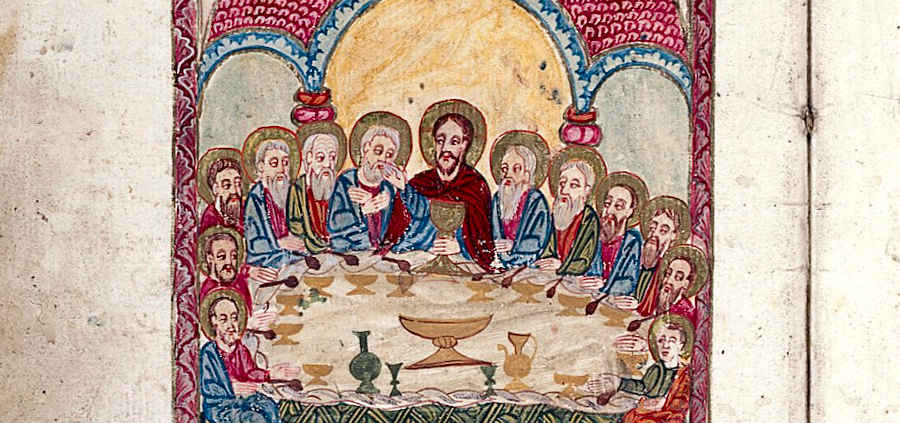From I to We by Ray Temmerman
This article was originally published in the May 27, 2023, edition of La Croix International. We are grateful to the author and editors for permission to reprint it here—Ed.
Rabbi Jonathan Sacks, in his book Morality, speaks about the need to move our focus from the popularly individualistic “I” to the more communal “we,” suggesting that this is more conducive to the common good, without which civilization cannot survive.
Such a movement in focus is, I suggest, alive and well in the liturgy we call the Mass.
When the most recent liturgy of the Catholic Church was promulgated in 2011 in the General Instruction of the Roman Missal (GIRM), the Canadian Conference of Catholic Bishops published Pastoral Notes to accompany it. Within those notes we find one small but important rubric (#68): “The assembly stands . . . (e.g., from the Lord’s Prayer through communion until all have received).” The Canadian conference is, to my knowledge, the only bishops’ conference which has done this. (If others have also done so, there is little evidence that their rubric is being followed.)
Being at the time 63 years of age, and having grown up with the practice of taking time after communion to quietly enter into private prayer, I grumbled at the change to my way of prayer.
Over time, however, as I learned to live that rubric, I began to sense a rich theology and ecclesiology at work.
Having shared the scripture stories, then having had their nourishment broken open for us in the homily, we come to that place in the liturgy where we say, “I believe.” We don’t say, “We believe.” While faith normally comes through the community, is passed on from it, nurtured by it, grows within it, it is still the individual who comes to faith, makes that personal statement of faith. We move, by the grace of God through the community, to the point where we are able to declare that faith as a unique particular person.
With that, an important dynamic happens. Having made a personal statement of faith, we find ourselves, through thanksgiving (Ευχαριστία), called and gifted to be part of one family, brothers and sisters all, regardless of race or color.
The best sign of this dynamic can be found in the Lord’s Prayer.
In that prayer, every statement referring to God is in the singular, while every statement referring to human beings is in the plural/communal. This is key to the whole dynamic of faith.
Having made our personal statement of faith, we as unique persons are incorporated into a community, a body, formed of all of us together. We all have the same Father, who is the subject of our joint request for the bread we need for that day, for forgiveness for our sins (a forgiveness dependent on our willingness to forgive others), and for freedom from evil.
It is this communal dimension which is wonderfully expressed in that additional rubric of the Canadian Conference of Catholic Bishops.
In their guidance on the liturgy, each person goes forward to receive the body and blood of Christ, then returns to that person’s seat. Then, however, rather than psychologically leaving the table, we actively remain together at the divine/human table/meal until the last member of the family has received.
That action shows us something key to a life of faith. The Mass is not a celebration of a group of individuals praying in one place. Rather, it is a thanksgiving celebration of one family, one body, united in faith. It is the whole body, not this or that part of it, which is sharing the family stories, giving thanks, taking, eating and drinking, then leaving to live life to the full for the next week.
At mealtime, does our family come to the table, take food, and each head off into our own private world? Or do we sit and eat together, swapping stories, discussing and debating, being reconciled, making plans for the future? I suggest not too many families will stay together if they do not, at least in the main, share their meals together.
Why should that divine/human meal which is the Eucharist not be the same? When we go up to receive, take and eat, take and drink, then return to our seats where we remain standing, we are by our bodily action expressing, and thereby reinforcing, that we are one body, together at one sacred meal. No one is leaving before all are fed. It is a sign of a community, a unity, that is ours to be part of, ours to strengthen, together.
God shows us, in Jesus, that while we are unique in ourselves, we are graced to no longer be alone. The place for individualism is gone, replaced by the call to be a unique part of one body, playing a full and active part in and of that body, caring for and being cared for by the other equally unique parts of that same body.
If humanity is to survive, it is that awareness, that understanding, that lived reality which needs to be present and active, not just in the religious realm, but in society and the body politic. The liturgy shows us the way. ♦
Ray Temmerman (Catholic), with his wife Fenella (Anglican), administers the website of the Interchurch Families International Network. A former Board member of the Association for the Rights of Catholics in the Church (ARCC), he continues to conduct research into the place of interchurch families and the gift they bring to their churches and the Church.





Leave a Reply
Want to join the discussion?Feel free to contribute!